
Copyright
Rockhounding
in Nunavut, Canada's
Newest Territory
BY JOHN THOMAS*
* Secretary / treasurer of the Iqaluit Rockhound Association, Iqaluit, Nunavut.
| |
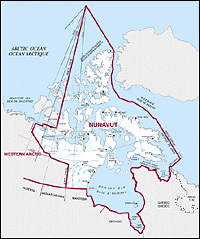
Map of Nunavut Territory.
|
On April 1st, 1999, the Northwest Territories was divided in two to create Canada's third northern territory called Nunavut, which in Inuktitut means "Our Land". The establishment of Nunavut was the end result of more than 20 years of dedicated, tenacious and patient negotiations by Canada's eastern arctic Inuit towards the settlement of their Land Claim Agreement with the Canadian federal government. Since the settlement of the NLCA and the establishment of the new territory, the prospects for mineral, gas and oil exploration have become more inviting and promising as both the Nunavut Government and the Inuit land claim organization Nunavut Tunngavit Inc (NTI) have stated that the Territory is now open for business. The federal government also showed that they too were committed to the industry potential by establishing the Canada-Nunavut Geo-Science Centre in Iqaluit.
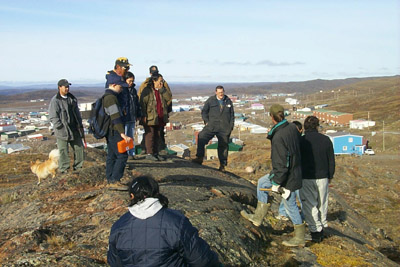
Members of the new Iqaluit Rockhound Association on a field collecting trip near Iqaluit. Photo by Elise Maltin.
In the 23 small communities scattered throughout the largest land mass of any province or territory in Canada, the potential of virtually unexplored lands for mineral deposits has local people getting more and more involved in prospecting their respective areas. Since Inuit have always lived out on the land, they have the necessary knowledge and experience of their surroundings and the expertise to travel and survive in what can be one of the world's most hostile environments.
The new Nunavut Government's Department of Sustainable Development has also been busy holding Prospector's courses in the communities and the response and enthusiasm of local people has been exceptional. This spring in Iqaluit, the capital of Nunavut, approximately 15 Iqalungmuit attended a Prospector's course that was held over 6 days. Armed with the knowledge they gained from the course, many were eager for the July sea ice breakup to occur and begin exploring the Tasiujarjuaq (Frobisher Bay) area. As a result of the course, several of the participants decided that a local rock and mineral club would be a good idea to further share knowledge amongst those who wanted to learn more about geology and as a means of getting together to sponsor various events and methods of collecting information and resources on the region. Thus the Iqaluit Rockhound Association was born on June 24, 2000.
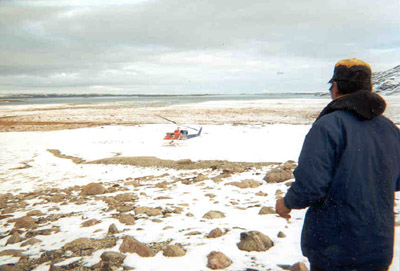
The Iqaluit Rockhound Association organizes some of its field trips by helicopter to access collecting localities. Photo by Suzanne Evaloardjuk.
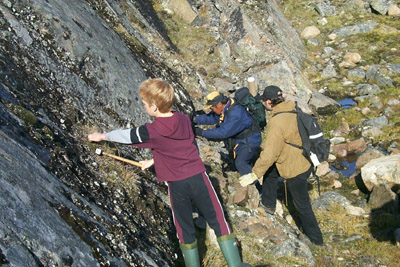
Members collecting rocks and minerals. Photo by Elise Maltin.
After meeting several times since then, the club has made plans to build and catalogue a rock and mineral collection of the Tasiujarjuaq (Frobisher Bay) area, organized club field trips by helicopter and hiking, produced a club newsletter and participated in the Great Baffin Rock & Mineral Contest sponsored by Qikiqtaaluk Corporation's Mineral Division. There are also plans to build a website and establish a permanent club office, where our collection can be displayed and resource materials stored. During club meetings, members have what is called a "show and analysis" segment to look at and discuss some of the specimens that have been collected.
| |
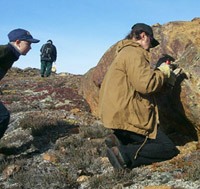
Members of the Iqaluit Rockhound Association are planning to build and catalogue a rock and mineral collection of the Tasiujarjuaq (Frobisher Bay) area. Photo by Elise Maltin.
|
In early November, the Association was represented at the Nunavut Mining Symposium in Rankin Inlet and further steps are now being taken to establish a Territorial-wide organization for local prospectors and rockhounds. With all the present and future mining activity and the many yet unexplored lands, the mining industry and government will be looking to local people to participate in all aspects of the industry. In a region with such a limited economic base, aside from tourism, hunting and fishing and government, Nunavut realizes that the development of its oil, gas and mineral resources along with a balanced approach to environmental concerns, will be its greatest hope and its greatest challenge. These are indeed exciting times in Nunavut.

Copyright © 2001 John Thomas
E-mail: jthomas@gov.nu.ca
This article may not be copied, distributed or reprinted in any form without the author's permission. To contact the author, please use the e-mail address provided. If you are unable to contact the author, please contact the Canadian Rockhound. Authorized reprints must acknowledge the author and the Canadian Rockhound, and include the website URL address of the Canadian Rockhound.
The photographs for this article were provided courtesy of Suzanne Evaloardjuk and Elise Maltin. Photographs used in this article may not be copied, distributed or reprinted in any form without permission. Please contact the author for more information.
More on Copyright

Document Number: CR0105102







